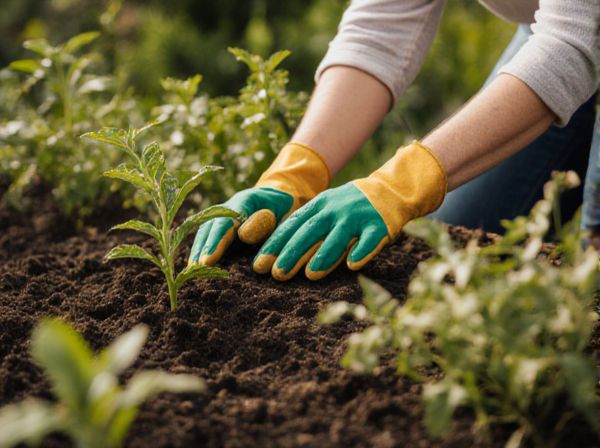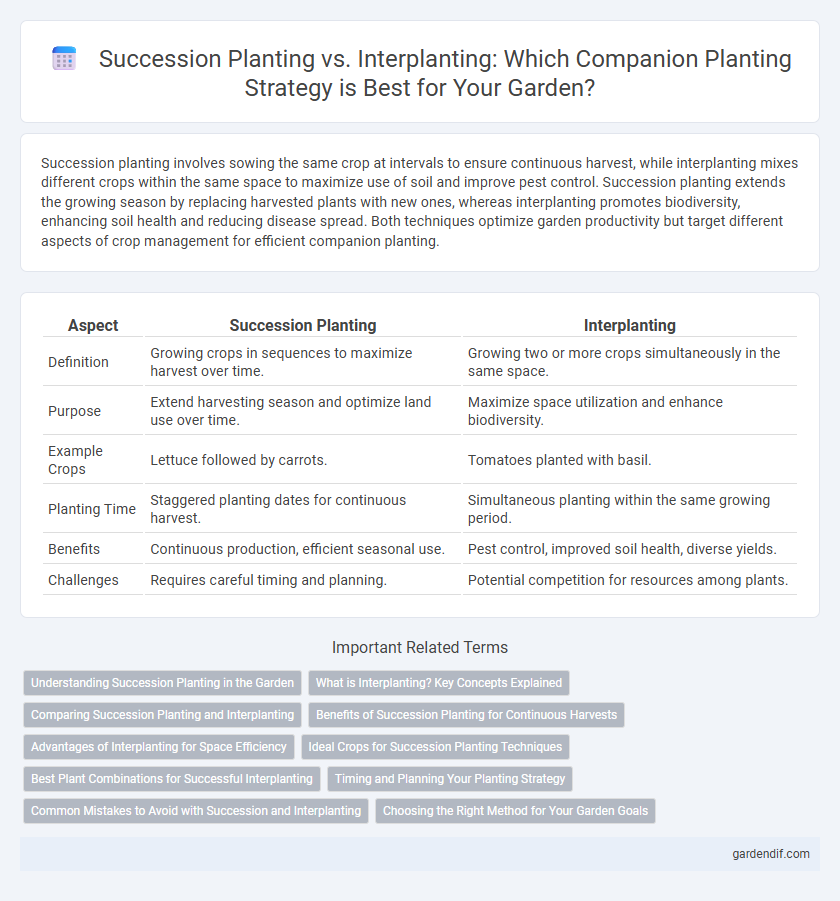
Succession planting vs interplanting Illustration
Succession planting involves sowing the same crop at intervals to ensure continuous harvest, while interplanting mixes different crops within the same space to maximize use of soil and improve pest control. Succession planting extends the growing season by replacing harvested plants with new ones, whereas interplanting promotes biodiversity, enhancing soil health and reducing disease spread. Both techniques optimize garden productivity but target different aspects of crop management for efficient companion planting.
Table of Comparison
| Aspect | Succession Planting | Interplanting |
|---|---|---|
| Definition | Growing crops in sequences to maximize harvest over time. | Growing two or more crops simultaneously in the same space. |
| Purpose | Extend harvesting season and optimize land use over time. | Maximize space utilization and enhance biodiversity. |
| Example Crops | Lettuce followed by carrots. | Tomatoes planted with basil. |
| Planting Time | Staggered planting dates for continuous harvest. | Simultaneous planting within the same growing period. |
| Benefits | Continuous production, efficient seasonal use. | Pest control, improved soil health, diverse yields. |
| Challenges | Requires careful timing and planning. | Potential competition for resources among plants. |
Understanding Succession Planting in the Garden
Succession planting involves growing different crops in the same space sequentially throughout the growing season to maximize garden yield and maintain continuous harvests. This method contrasts with interplanting, where multiple crops are grown simultaneously in close proximity to optimize space and promote beneficial plant interactions. Understanding succession planting allows gardeners to plan crop rotations, enhance soil health, and reduce pest and disease incidence by staggering planting times.
What is Interplanting? Key Concepts Explained
Interplanting is the practice of growing two or more crop species simultaneously in the same space to maximize yield and promote biodiversity. This method enhances pest control, improves soil fertility, and optimizes resource use by combining plants with complementary growth habits and nutrient requirements. Unlike succession planting, which staggers planting times, interplanting focuses on spatial diversity within the same growing period.
Comparing Succession Planting and Interplanting
Succession planting involves growing crops in a specific sequence to maximize space and harvest periods, ensuring continuous yield throughout the growing season. Interplanting mixes different crops simultaneously in the same area, promoting biodiversity, pest control, and better resource utilization. Both methods optimize garden productivity, but succession planting emphasizes time-based crop rotation, while interplanting focuses on spatial diversity and symbiotic relationships.
Benefits of Succession Planting for Continuous Harvests
Succession planting maximizes garden productivity by staggering crops, ensuring a steady supply of fresh produce throughout the growing season. This method reduces soil nutrient depletion and pest buildup by rotating plant families in timed intervals, promoting healthier growth. Continuous harvests from succession planting support sustainable gardening practices, improving companion plant synergy and overall yield.
Advantages of Interplanting for Space Efficiency
Interplanting maximizes garden space by allowing multiple crops to grow simultaneously within the same area, reducing idle soil and increasing overall yield. This method supports efficient resource use, such as sunlight, water, and nutrients, by pairing compatible plants with differing growth habits or root depths. Interplanting also enhances pest control and soil health, creating a synergistic environment that succession planting alone may not achieve.
Ideal Crops for Succession Planting Techniques
Succession planting thrives with fast-maturing crops like lettuce, radishes, and spinach, which ensure a continuous harvest by staggering planting times. Crops such as beans, carrots, and peas also perform well because they fit different growth cycles and replenish soil nutrients. This technique maximizes space and productivity by replacing harvested plants with new crops efficiently.
Best Plant Combinations for Successful Interplanting
Succession planting and interplanting both maximize garden yields, but interplanting requires strategic plant pairings to optimize space and nutrient use. Combining fast-growing crops like radishes with slower-growing ones such as carrots or onions ensures efficient growth and timely harvests. Best plant combinations include tomatoes with basil, corn with beans and squash, and lettuce with beets, promoting pest control, improved soil health, and increased productivity.
Timing and Planning Your Planting Strategy
Succession planting ensures a continuous harvest by staggering crop intervals, allowing better timing aligned with seasonal growth cycles. Interplanting maximizes space by growing complementary plants simultaneously, optimizing nutrient use and pest control throughout the growing season. Planning your planting strategy involves assessing growth rates and sunlight requirements to harmonize crop development and improve overall yield.
Common Mistakes to Avoid with Succession and Interplanting
Succession planting and interplanting require careful timing to avoid overcrowding and nutrient competition, common mistakes that reduce crop yield and health. Failing to account for each plant's growth cycles and spacing can lead to stunted development and increased susceptibility to pests. Proper planning using crop rotation principles and understanding companion planting benefits ensures optimal soil use and minimizes the risk of spreading diseases.
Choosing the Right Method for Your Garden Goals
Succession planting maximizes continuous harvest by staggering crop growth, ideal for gardeners seeking consistent yields throughout the season. Interplanting enhances soil health and pest control by growing complementary plants together, perfect for improving biodiversity in limited spaces. Selecting the right method depends on your garden goals--opt for succession planting to extend production or interplanting to boost ecosystem resilience and resource efficiency.
Succession planting vs interplanting Infographic

 gardendif.com
gardendif.com